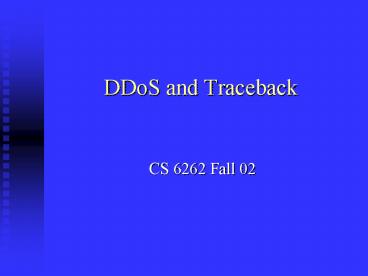DDoS and Traceback - PowerPoint PPT Presentation
1 / 20
Title:
DDoS and Traceback
Description:
Attacker uses encrypted TCP; Masters and zombies use TCP and ICMP echo reply; ... Control messages between attacker, masters, and zombies ' ... – PowerPoint PPT presentation
Number of Views:117
Avg rating:3.0/5.0
Title: DDoS and Traceback
1
DDoS and Traceback
- CS 6262 Fall 02
2
Denial-of-Service (DoS) Attacks(via
Resource/bandwidth consumption)
3
TCP Handshake
server
client
SYN seqx
SYN seqy, ACK x1
ACK y1
connection established
4
IP Spoofing SYN Flood
- X establishes a TCP connection with B assuming
As IP address
(3) SYN(seqn) ACK(seqm1)
A
B
SYN(seqm),srcA
(1) SYN Flood
(2)
(4) ACK(seqn1)
(0) predict Bs TCP seq. behavior
X
5
ping
smurf
6
Distributed DoS (DDoS) Attacks
zombies
masters
attacker
victim
7
DDoS Common Steps
- Initiate a scan phase in which a large number of
computers (100,000) on the internet are probed
for known vulnerabilities. - Exploit the vulnerabilities to compromised the
computers to gain access. - Install attack tools on each compromised host,
and use the compromised hosts for further
scanning/compromises. - A subset of the compromised hosts with desired
architecture/topology are chosen to form the
attack network. - Install attack and communication tools.
- Tell the masters to attack.
8
DDoS At Least 4 Versions
- Trinoo
- Attacker uses TCP Masters and zombies use UDP
password authentication. - TFN
- Attacker uses shell to invoke master Masters and
zombies use ICMP echo reply. - TFN2K
- A Combination of UDP, ICMP, and TCP.
- Stacheldraht
- Attacker uses encrypted TCP Masters and zombies
use TCP and ICMP echo reply rcp used for
auto-update.
9
DDoS Example Trinoo
- Scanning
- Buffer overflow bug in Solaris and Linux, e.g.,
wu-ftpd, statd, amd, etc. - A compromised node has a shell running as root
and sends back confirmation. - Installing attack program
- Use netcat (nc) to pipe a shell script to the
shell (running as root) on the compromised host - Attacker to master
- TCP Must provide password commands dos IP
etc. - Master to zombie
- UDP Command line includes password commands
aaa pass IP rsz N, etc.
10
DDoS What to Do About It
- Not a whole lot!
- Prevention
- Detection
- Traceback
11
DDoS Prevention
- Authentication.
- Not feasible in practice.
- Ingress filtering on the routers.
- Traffic volume monitoring.
- Rate limit certain traffics, e.g., ICMP packets,
SYN packets. - Measure normal rates first!
12
DDoS Detection
- Surge in traffic volume
- Too much traffic to a particular destination
- Specific to current DDoS tools
- Control messages between attacker, masters, and
zombies - Footprints of attack programs running on
masters and zombies - What is after detection?
- Stop the flood
13
Traceback
- Why
- Stop the attacks
- Gather evidence for law enforcement
- Only to machines that directly generate the
attack traffics - For the real masters/attackers more forensic
analysis necessary - Difficulty
- Spoofed IP source addresses
14
Traceback Several Proposals
- Link Testing
- ICMP Traceback
- Probabilistic Marking
15
Link Testing Input Debugging
- Victim reports to upstream router, which installs
debugging filter that reveals which upstream
router originated the traffic. - Repeat recursively until the the ISPs border
is reached. - The upstream ISP is contacted and repeats the
process. - Considerable management overhead.
- Relying on the availability and willingness of
the network operators.
16
Link Testing Controlled Flooding
- Victim coerces selected hosts along the upstream
route to iteratively flood each incoming link of
the router closest to the victim. - Infer which link the attack comes from by
observing the attack packet rate changes - Router buffers are shared.
- Repeat recursively
- A form of DoS itself!
- Need to have a good network topology map.
17
ICMP Traceback
- For a very few packets (about 1 in 20,000), each
router will send the destination a new ICMP
packet that includes the contents of that packet
and information about previous hop for that
packet. - The flood victim can use these ICMP packets to
reconstruct the path back to the attacker. - Net traffic increase at end point is about 0.1 -
probably acceptable. - Issues authentication (attacker can falsify the
ICMP packets), loss of traceback packets, load
and cooperation on routers.
18
Probabilistic Marking
- Basic idea
- Probabilistically mark packets with partial path
information as they arrive at routers. - Each marked packet represents a sample of its
path. - But flooding attacks comprise a large number of
packets. - By combing a modest number of these marked
packets, the entire path can be reconstructed.
19
The Node Append Algorithm
- Marking procedure at router R
- For each packet w, append R to w.
- Path reconstruction procedure at victim
- For any packet w from attacker
- Extract (Ri, , Rj) from suffix of w.
- High overhead at router.
- Not enough space at packet.
20
The Node Sampling Algorithm
- Marking procedure at router R
- For each packet w,
- Roll the dice let x be a random number in
0..1. - if x lt p then write R to w.node.
- Path reconstruction procedure at victim
- For any packet w from attacker
- Let NodeTbl be a table of (node,count)
- z lookup w.node in NodeTbl
- if z is not nil then increment z.count else
insert (w.node,1) in NodeTbl - Sort NodeTbl by the count field
- Extract path (Ri, , Rj) from ordered node fields.































